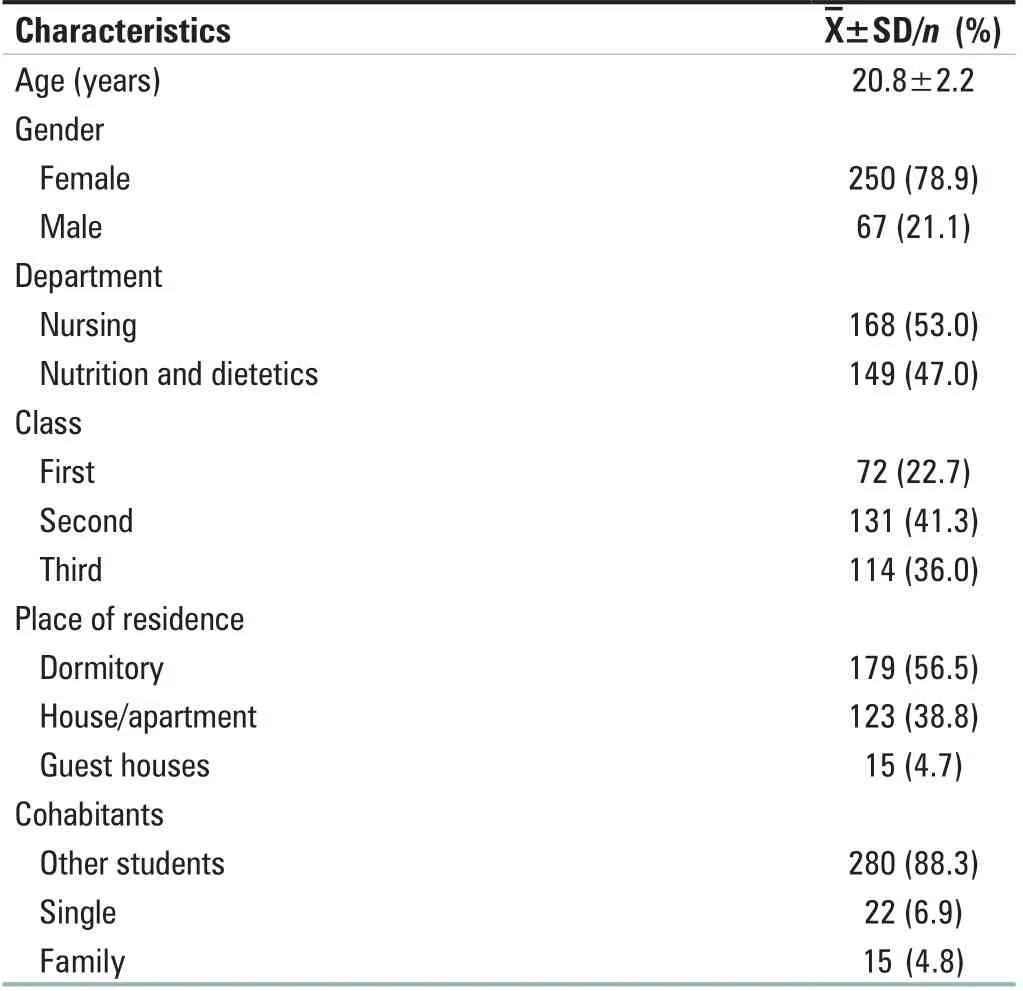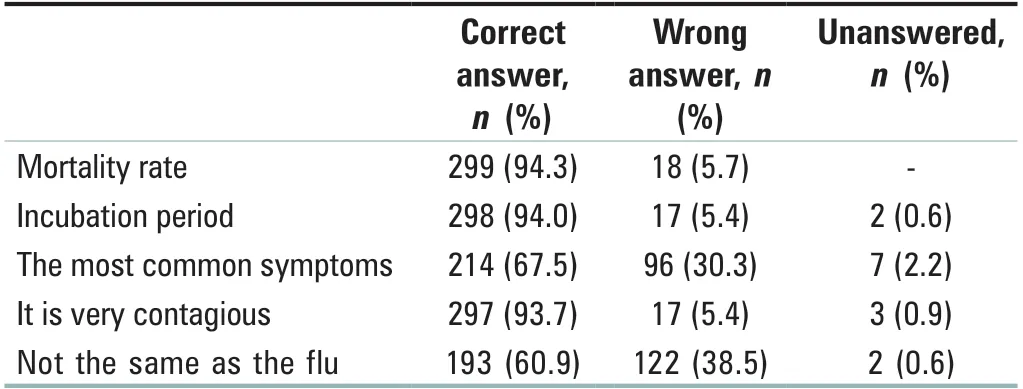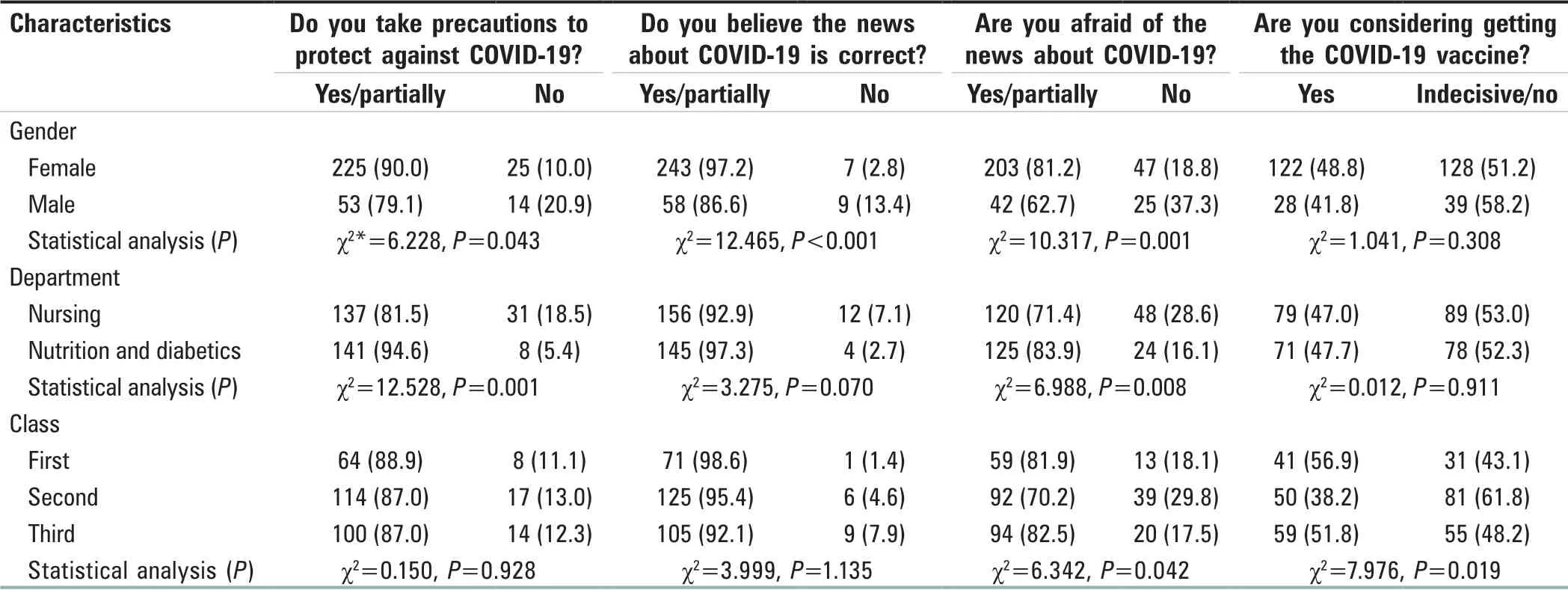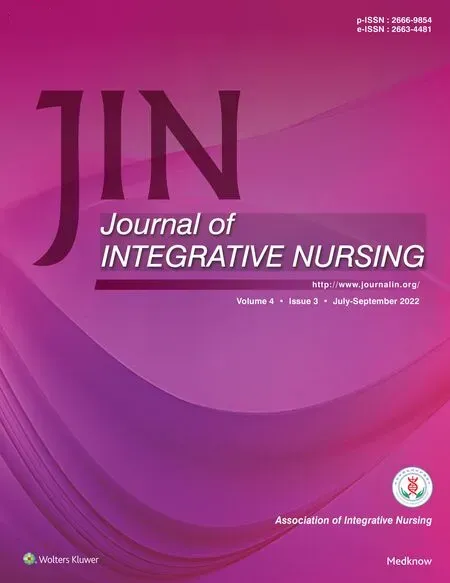Faculty of health sciences students’ knowledge and attitudes toward coronavirus disease 2019 during the first wave of the pandemic: A cross-sectional survey
2022-10-10MelekErtrkYAVUZBaharCandaALTINBADidemSARIMEHMETAylaRSOYCanselZEL
Melek Ertürk YAVUZ, Bahar Candaş ALTINBAŞ, Didem SARIMEHMET, Ayla GÜRSOY, Cansel ÖZEL
1Department of Surgical Nursing, Faculty of Health Sciences, Artvin Çoruh University, Artvin, Turkey; 2Department of Surgical Nursing, Faculty of Health Sciences, Karadeniz Technical University, Trabzon, Turkey; 3Department of Medical Services and Techniques, Vocational School of Health Sciences, Karadeniz Technical University, Trabzon, Turkey; 4Department of Surgical Nursing, Faculty of Health Sciences, Antalya Bilim University, Antalya, Turkey; 5Neonatal Intensive Care Unit, Elazığ Medikalpark Hospital, Elazığ, Turkey
Faculty of health sciences students’ knowledge and attitudes toward coronavirus disease 2019 during the first wave of the pandemic: A cross-sectional survey
Melek Ertürk YAVUZ1, Bahar Candaş ALTINBAŞ2, Didem SARIMEHMET3, Ayla GÜRSOY4, Cansel ÖZEL5
1Department of Surgical Nursing, Faculty of Health Sciences, Artvin Çoruh University, Artvin, Turkey;2Department of Surgical Nursing, Faculty of Health Sciences, Karadeniz Technical University, Trabzon, Turkey;3Department of Medical Services and Techniques, Vocational School of Health Sciences, Karadeniz Technical University, Trabzon, Turkey;4Department of Surgical Nursing, Faculty of Health Sciences, Antalya Bilim University, Antalya, Turkey;5Neonatal Intensive Care Unit, Elazığ Medikalpark Hospital, Elazığ, Turkey
ABSTRACTObjective:The study aimed to determine the faculty of the health sciences students’ knowledge and attitudes regarding the coronavirus disease 2019 (COVID-19) pandemic.Materials and Methods:This cross-sectional survey was completed with 317 undergraduate students of one health sciences faculty in Turkey. The data were collected between March 1, 2020, and March 15, 2020, by face-to-face interviews using a questionnaire created by the researchers. Number, percentage, mean, standard deviation, and PearsonChi-square test were used to evaluate the data.Results:In this study, a high proportion of students answered questions about COVID-19 correctly. About 55.8% of the students took partial precautions against COVID-19 to protect themselves against COVID-19 and “frequent washing of hands” was the most common precaution. We determined that the main reasons for not taking any precautions against COVID-19 were “low number of cases in Turkey” and “getting irritated by the mask.” About 98.4% of the participants were entirely/partially following the news on COVID-19, with social media being the most commonly used medium. Female students took more protective measures than male students. The 1st-year students had more positive thoughts about vaccination compared to those in the other classes.Conclusions:Although the knowledge of the students about COVID-19 was good in the first wave of the pandemic, more than half of the students stated that they partially complied with the protective measures.
Keywords:Attitude, COVID-19, knowledge, pandemic, student
Address for correspondence:Ayla GÜRSOY, Faculty of Health Sciences, Antalya Bilim University, Çıplaklı District, Akdeniz Street, No: 290, 07190, Antalya, Turkey.
E‑mail: aylagursoy68@gmail.com
Submitted:29-Mar-2022
Revised:26-Apr-2022
Accepted:19-May-2022
Published:29-Sep-2022
This is an open access journal, and articles are distributed under the terms of the Creative Commons Attribution-NonCommercial-ShareAlike 4.0 License, which allows others to remix, tweak, and build upon the work non-commercially, as long as appropriate credit is given and the new creations are licensed under the identical terms.
For reprints contact:WKHLRPMedknow_reprints@wolterskluwer.com
How to cite this article:Yavuz ME, Altinbaş BC, Sarimehmet D, Gürsoy A, Özel C. Faculty of health sciences students' knowledge and attitudes toward coronavirus disease 2019 during the first wave of the pandemic: A cross-sectional survey. J Integr Nurs 2022;4:151-6.

Access this article online Quick Response Code Website:www.journalin.org DOI:10.4103/jin.jin_30_22images/BZ_50_966_2775_1202_3011.png
INTRODUCTION
First appeared in Wuhan city of China’s Hubei province on December 31, 2019, coronavirus disease 2019 (COVID-19) was caused by severe acute respiratory syndrome coronavirus-2 (SARS-CoV-2) rapidly affected the whole world.[1,2]The negative impact of COVID-19, declared as a pandemic by The World Health Organization in Turkey, began with the appearance of the first positive cases on March 11, 2020. SARS-CoV-2 is one of the significant pathogens targeting the respiratory system, and is associated with systemic and respiratory symptoms.[3-5]COVID-19 is transmitted mainly by droplets but can also be transmitted by touching the mouth, nose, or eyes with contaminated hands after contact with surfaces contaminated by the droplets emitted by infected individuals at close range by coughing and sneezing.[4]
Protecting oneself against the disease is the most rational and effective method of preventing the disease. Protection aims to prevent new cases and deaths, thereby controlling the pandemic.[6]The most efficient way to be protected from COVID-19 is avoiding exposure to the virus. People should wear masks correctly, wash their hands with soap and water for at least 20 s, maintain social distance (1.5 m), and avoid going into crowded areas to achieve this protection. Furthermore, precautions such as scrubbing communal locations (door handles, tables, laptops, etc.) with diluted bleach, not using shared items (towels, glasses, etc.), having a balanced diet, and following travel limitations are required.[5]
There are several studies to explore the virological characteristics and clinical outcomes of COVID-19. However, there are not enough studies focusing on the knowledge, perceived seriousness, and controllability of COVID-19 among individuals experiencing the pandemic.[5]As in most epidemics and pandemics, health-care workers are at the forefront of the fight against COVID-19. This is even more critical for health-care professionals, service providers, and prospective students. After graduation, health-care students will be the first to be in close contact with people affected by the virus. This proximity may increase their stress levels and interrupt their educational progress.[7]
Knowing the knowledge and attitudes of health sciences faculty students about COVID-19 will guide practices and plans for future pandemics. This knowledge will also provide an insight into the planning of in-service training for the students after they graduate. Furthermore, it is expected that the students of the faculty of health sciences will be more sensitive about protection from the disease during the pandemic.[8]The knowledge obtained from these students will help us to predict the approach of other segments of society to the subject.
The aim of our study is to determine the level of knowledge about COVID-19 and attitudes about the ways of protection of the students in the faculty of health sciences (nursing and nutrition and dietetics departments).
MATERIALS AND METHODS
Study design
This was a cross-sectional survey carried out during the COVID-19 pandemic between March 1, 2020, and March 15, 2020.
Participants
The population of the study consisted of nursing and nutrition and dietetics students (n= 558) studying at a health sciences faculty in Turkey. It was aimed to reach the entire population without employing certain sampling criteria. Students who were pretested during the data collection process did not agree to participate in the study, returned incomplete data forms, and could not be interviewed due to the interruption of face-to-face education were not included in the study. The study was thus conducted with a total of 317 students, reaching 56.8% of the population.
Instruments and procedure
The “Question Form” prepared by the researchers was used as a data collection tool in the study. The form consists of 17 questions. The first six questions were about demographic characteristics (age, gender, department, class, place of residence, and cohabitants). The remaining 11 questions were about COVID-19 (knowledge about COVID-19, whether they took precautions, measures taken, reasons for not being protected, etc.). Five experts evaluated the form for content validity. As a result of this evaluation, we made necessary revisions, and a pilot study was performed with ten students, who were excluded from the study. The study data were collected through face-to-face interviews. The questionnaires were distributed to the students by the researchers in the classroom environment. The interviews lasted for approximately 5-10 min. The forms were filled out by the students in the classroom environment.
Data analysis
The data obtained from the study were analyzed using the Statistical Package for the Social Scinces (SPSS) IBM version 21 software package, New York, America. Number, percentage, mean, standard deviation, and PearsonChi-square test were used to evaluate the data.
Ethical considerations
Ethical approval was obtained from the Artvin Coruh University Scientific Research and Publication Ethics Committee (17.06.2020-E.6349), and institutional permission was taken from the relevant institution to conduct the study. No personal data (name, surname, student number, country) were obtained from the students, and participation in the survey was carried out voluntarily. All students were informed regarding the purposes of this survey and of their right to withdraw from it, and verbal consent was acquired from the students.
RESULTS
The mean age of the students was 20.8 ± 2.2 years. About 78.9% were female, 53.0% were nursing students, 41.3% were 2nd-year students, 56.5% stayed in a dormitory, and 88.3% lived with other students [Table 1].
About 55.8% of the participants stated that they partially complied with the measures to protect themselves from COVID-19. The distribution of the answers given by the health sciences faculty students to the questions about the COVID-19 pandemic is given in Table 2.
The most common measures students took were washing hands frequently (92.4%), not touching the mouth, nose, and eyes with dirty hands (90.6%), and not sharing personal items such as towels and glasses (83.8%). While 47.3% of the participants stated that they would get the COVID-19 vaccine when it is developed, 38.5% were indecisive [Table 3].
The main reasons for not taking precautions against COVID-19 among the students who stated that they did not take any precautions (n= 39, 12.3%) were the low number of cases in Turkey (87.2%) and being irritated by the mask (46.2%). Furthermore, “high cost of masks, hand disinfectants, and similar products to be used for prevention (30.8%) were among the main reasons for not taking precautions.Students followed the news about COVID-19 (55.2%), 51.1% “partially” believed the news and 41.0% were “partially” afraid of the news [Table 4]. The students following or partially following the news on COVID-19 obtained knowledge mostly from social media (88.5%), television (75.6%), and people around them (48.3%). About 46.6% of the students expressed that they searched for news about COVID-19 on the Internet.Table 5 shows the distribution of students’ knowledge and attitudes about COVID-19 according to their sociodemographic characteristics.

Table 1: Sociodemographic characteristics of the students

Table 2: Student's knowledge of coronavirus disease 2019

Table 3: Student’s attitude toward protection from coronavirus disease 2019 and precautions

Table 4: Student’s attitude toward news related to coronavirus disease 2019

Table 5: Distribution of knowledge and attitudes about coronavirus disease 2019 according to sociodemographic characteristics of students
DISCUSSION
There were many unanswered questions about COVID-19 early in the pandemic. People did not have enough knowledge on the subject yet. Still, we determined that the majority of the students gave correct answers to the questions on the pandemic. Since the COVID-19 pandemic is a serious public health problem that concerns the whole society, it is normal for students to have a high level of knowledge. Some studies in the literature have reported similar findings to our research,[7,9-11]whereas some others described low levels of knowledge about COVID-19.[12-14]This difference may be due to education differences about COVID-19 in different countries and variations in the opportunities and access to knowledge from sources such as social media.[15]
More than half of the students adopted “partial” measures to protect themselves against COVID-19, and about one-third took all the specified ones. In the systematic review of studies with physicians, health-care professionals, and the general population found that the attitude toward COVID-19 was positive in 82% of the studies.[16]Our finding is not consistent with the literature in this respect. Since we collected the data during the initial period of COVID-19, we believe that the students did not take adequate protective measures. Even if many people are aware of COVID-19, it may take time to transfer that knowledge into behavior.
Frequent washing of the hands with soap, not touching the mouth, nose, and eyes with dirty hands, and not using shared items were the most frequent measures and were frequently implemented. However, people did not follow precautions such as wearing masks and using hand disinfectants. According to the literature, frequent washing of hands, hand disinfectants and masks, and social isolation are the key measures to protect oneself against COVID-19.[9,13,14,17-20]While the rate of wearing masks was high in some studies,[18,21]another study has reported low rates, which is similar to our findings.[10,11,17,22]We believe that the reason why students did not take adequate protection measures was that we collected the study data during the early COVID-19 pandemic. Although most of the students had knowledge about COVID-19, it takes time to turn the knowledge into practice.
We determined that the students who did not take protective measures considered the number of cases in the country low. Besides, they felt that wearing masks irritated them and that the products to be used for protection were expensive, and hence, they did not take preventive measures. In similar studies, the reasons for not taking protective measures were lack of material, high cost, uncertainty about precautions, and not being able to get used to new conditions such as wearing a mask and staying at home.[16,22]Within the scope of COVID-19 measures, quarantine is imposed on anyone suspected of having come into contact with a case. Home visits are also restricted, and the 1.5 m social distance limit is suggested. These practices curtail the spread of the pandemic. In our study, students tend to adhere to rules that can prevent the spread of the pandemic. About half of the students considered getting vaccinated when the COVID-19 vaccine becomes available. More than a third, on the other hand, were still undecided. The rate of considering getting vaccinated against COVID-19 was 92.4% in the study of Huynhet al.[23]and 86.2% in the study of Ikhlaqet al.,[24]both of which are higher than the finding in the present study. Various frightening theories about vaccines were spreading in Turkey, resulting in the minimal number of students considering immunization.
Almost all of the students (totally or partially) followed the news on COVID-19. More than three-quarters of the participants followed the social media and television news. In this study, social media was the primary source of knowledge as in similar studies, followed by television and the Internet.[9]The fact that the knowledge on social media is easy to access, cost-effective, and wide-ranging contributes to its use as the chief source of information. Half of the students partially believed the news about COVID-19, and the other half trusted the news completely. Almost half of the students were somewhat afraid of COVID-19 information, and more than a third were completely afraid. In the study of Royet al.,[25]the participants experienced anxiety and fear. With the onset of COVID-19 cases, fake news has also appeared on social media and the Internet. Hence, the students view the news with suspicion and are partially afraid.
It was determined that female students took more precautions to protect themselves from COVID-19, believed more in the accuracy of the news about COVID-19, and were more afraid of such news. In line with the present study results, there is literature evidence that females take more precautions than men to protect themselves from COVID-19.[18,21,26,27]Studies on COVID-19 have reported higher anxiety levels for females. Again, in the same studies, a positive relationship was found between high anxiety and taking precautions against COVID-19.[10,18]We determined that the students of the nutrition and dietetics department took more precautions to protect themselves from COVID-19 and were more afraid of the news about COVID-19 than the students of the nursing department. The result obtained in our study is surprising since nursing students are more likely to encounter patients with COVID-19, they are expected to take more protective measures and be more afraid of the news about the pandemic. We determined that students’ academic year did not affect their ability to apply protective measures and believe the news about COVID-19. However, 2nd-year students were less afraid of the news about COVID-19 compared to other classes, and the rate of considering getting vaccinated was less in these students. The COVID-19 pandemic was the first such experience for the students. Students had not been trained before related to this pandemic. For this reason, we can consider it normal that the students did not differ by their academic year in terms of taking protective measures and believing in the accuracy of the news. The differences of the 2nd-year students in certain topics may be related to their sociodemographic characteristics. Furthermore, we found that more than half of the 1st- and 3rd-year students and more than one-third of the 2nd-year students considered getting the COVID-19 vaccine, and the difference between these groups was statistically significant. In the literature, no research could be found to determine the relationship between class and the desire to be vaccinated. The desire to be vaccinated against COVID-19 will increase as the class level increases. The results of our study suggested that 2nd-year students’ desire to be vaccinated against COVID-19 was lower because of their personal traits (age, experiences, culture, etc.).
Limitations of the study
The study has some limitations. One of them is that there were only two departments (nursing and nutrition and dietetics) in the faculty of health sciences where the study was conducted. Another limitation of the study was the inability to collect data from 4th-year students because face-to-face training was interrupted during the conduct of the study. Furthermore, the study only includes data for the beginning of the pandemic. It is a limitation that the research does not include data from different periods of the pandemic.
CONCLUSIONS
Based on the data obtained from students during the early period of COVID-19 in Turkey, the health sciences students have a high level of knowledge about the pandemic. More than half of them take partial precautions to prevent the disease. Students frequently wash their hands as part of protective measures and obtain knowledge about COVID-19, mostly from social media and television news. However, only about half of the students consider getting the COVID-19 vaccine when it becomes available. Pandemic-related topics should be added to the curriculum of health-care professionals. Appropriate education should be given with methods aimed at developing the desired behavior, especially regarding personal protection rules. Furthermore, we recommend conducting new studies to evaluate the changes in students in the course of the pandemic.
Acknowledgments
We acknowledge Meryem Kılıç and Kader Kayım for their help during data collection.
Financial support and sponsorship
Nil.
Conflicts of interest
There are no conflicts of interest.
杂志排行
Journal of Integrative Nursing的其它文章
- Nursing perspective of Guidelines for Diagnosis and Treatment of Gout with lntegrated Traditional Chinese and Western Medicine
- Role of community health nurse in the prevention of elderly dehydration: A mini-review
- Technology-based psychosocial support for adolescent survivors of leukemia: An example intervention for nurse specialists
- Practice and patronage of traditional bonesetting in Ondo State, Nigeria
- Nurses and nursing students’ knowledge regarding blood transfusion: A comparative cross-sectional study
- Referral and counter-referral practices in obstetric emergencies among health-care providers in selected health facilities in Plateau state, Nigeria
